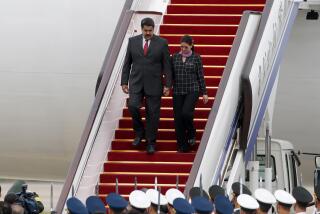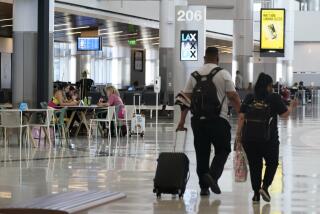Jet Hijacking Foiled After Cuban Eludes L.A. Security
A mentally troubled Mariel refugee who lived in Los Angeles smuggled a starter pistol, two knives and scissors past metal detectors at Los Angeles International Airport and unsuccessfully tried to hijack a plane home to Cuba on Saturday, authorities said.
The hijacking was foiled after the pilot of the American Airlines 727 jetliner, carrying 140 passengers, turned back about 60 miles south of Miami because the plane was almost out of fuel.
Pedro Rene Comas-Banos, 37, who had escaped from two mental hospitals during his stay in the United States, was arrested without incident and charged with air piracy, said William A. Gavin, head of the FBI’s Miami office. No one aboard the jetliner was injured.
Dressed in Fatigues
The aborted hijacking began after Comas-Banos paid $417 in cash for a one-way ticket from Los Angeles to Miami. Shortly after midnight Saturday, dressed in camouflage fatigues and a bomber-type jacket, the sandy-haired Comas-Banos carried two red satchels on board American Airlines Flight 30 to Dallas-Ft. Worth.
At 7 a.m., he left the Texas airport aboard Flight 1098. As the plane descended in its approach to Miami International Airport, Comas-Banos took out the starter pistol and demanded in a note to be flown to Jose Marti International Airport outside Havana, according to Gavin. Assisted by a Spanish-speaking passenger, he told the crew he had explosives with him and would blow up the plane.
Jack Barker, the Federal Aviation Administration’s regional spokesman, said in an interview from Georgia that air traffic controllers granted emergency permission for the plane to fly to Cuba. Barker said the plane headed south, but turned back because fuel was running low, landing in Miami at 11:30 a.m.
Agrees to Surrender
After negotiations with the FBI continued for about 90 minutes, Comas-Banos agreed to surrender. A search of his luggage turned up no explosive.
Born in Manzanilla, Cuba, he was sent to St. Elizabeths Hospital in Washington, D.C., shortly after arriving in the United States on May 27, 1980, during the Mariel boatlift. He escaped sometime in 1982, made his way to Los Angeles and was again hospitalized for psychiatric treatment at an unknown institution here, but again escaped, according to the FBI.
FBI spokesman Paul Miller said Comas-Banos had spent a considerable amount of time living on Los Angeles streets.
More to Read
Sign up for Essential California
The most important California stories and recommendations in your inbox every morning.
You may occasionally receive promotional content from the Los Angeles Times.










